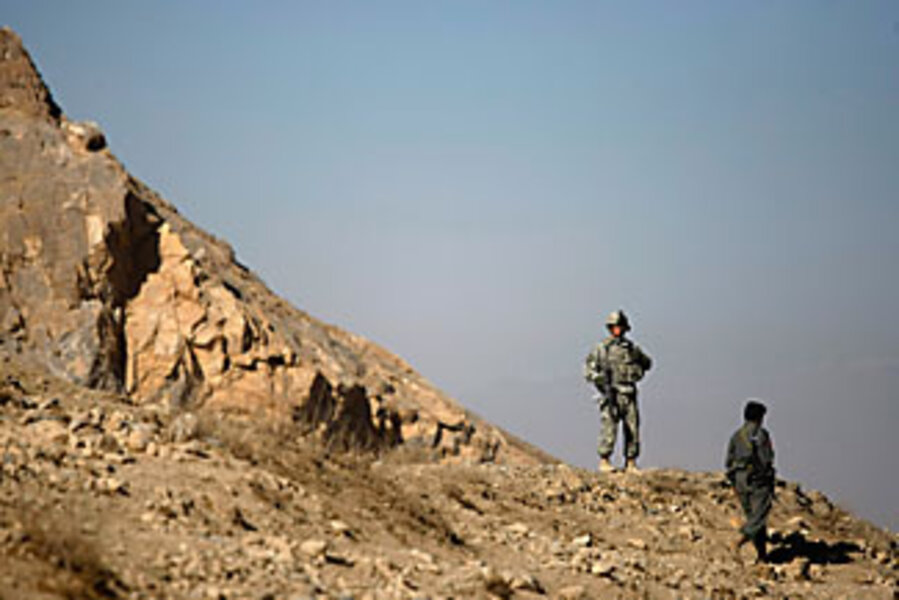Obama's new Afghanistan plan may be much like old one
Loading...
| Washington
The Afghanistan war plan President Obama will announce next week won't stray far from the strategy he laid out eight months ago, say experts.
After nine meetings with his war council – and reports of vigorous disagreement within the administration – Mr. Obama seems likely to stick to the strategy he announced in March, perhaps incorporating elements from other proposals.
His top general in Afghanistan favors a "counterinsurgency" approach that would entail a massive increase in the number of US troops there. Others such as Vice President Biden reportedly prefer a "counter-terrorism" policy that would emphasize targeted strikes on terrorist hideouts.
"There will be something in there for everyone," says one official who is close to the deliberations. "Nobody got everything, but everybody got something."
Obama indicated Tuesday that he was not shying away from the fight in Afghanistan. "It is in our strategic interest, in our national security interest, to make sure that Al Qaeda and its extremist allies cannot operate effectively in those areas," Obama said at the White House. "We are going to dismantle and degrade their capabilities and ultimately dismantle and destroy their networks."
Obama's plan is likely to include:
•More forces. Obama is expected to announce an increase of between 30,000 and 40,000 additional forces for Afghanistan on top of the 68,000 already there. Those forces will conduct combat missions as well as training missions to increase the size of the Afghan national security forces. The additional forces, depending on their number, will be used to shore up sparsely-deployed forces around the country or concentrated on populated areas.
•More civilians. For years, military officials in Afghanistan have complained that there aren't enough civilians to focus on non-military aspects such as economic development and governance. Expect an increase in civilian efforts in the coming year.
Deploying civilian expertise was a problem in Iraq even during the surge of forces there, and so-called civilian surge for Afghanistan will probably also fall short. It's not clear where the several hundred civilians – agricultural experts, educators, specialists in the rule of law and engineers – will come from. The American government is still largely unable to identify those civilians whose skills would be relevant to such a mission and deploy them accordingly. However, Secretary of State Hillary Rodham Clinton has made this issue a priority and is expected to be aggressive in deploying them under a new strategy.
•More Afghan National Security Forces. Developing a stronger indigenous security force in Afghanistan has long been seen as the key to ultimately leaving the country safe. But efforts to do so have until now lacked the resources and momentum. Democrats are calling for this to dominate the new strategy. Obama will emphasize growing the Afghan National Security Forces to about 400,000 – roughly double of the current goal – over the next few years.
•Deals with some Taliban. Many experts and military commanders believe that cutting deals with some elements of the Taliban can be effective, and Obama's new strategy will embrace this.
The "uncompromising core" of the Taliban must be met with force, Obama said in March. But the Taliban is also composed of militants who plant roadside bombs not out of ideology so much as economic necessity. Those kind of militants could be persuaded to lay down their arms and help the US and its allies keep the Taliban out of their communities.
It worked in Iraq. In 2006, insurgents in Sunni-dominated Anbar Province who felt Al Qaida had crossed the line and was terrorizing communities, began to turn against the terrorist group. This "awakening" was helped by some financial encouragement from the US. Many say that although Afghanistan is a very different society, the approach could work there, too.
•Bigger NATO contribution. The Bush administration spent years pressing NATO to do more in Afghanistan – unsuccessfully. But recently, NATO members and other countries seem to be becoming more amenable to the idea. Non-US contributions has grown since January, from 31,500 in January to around 42,000 today. Britain recently announced it would send another 500 troops and is expected to contribute even more. The US is also targeting Italy, Germany, France, and others to send more troops.
See also:
Afghanistan troop surge could be a slow rollout
Afghanistan war decision: how Robert Gates thinks
----
Follow us on Twitter.





